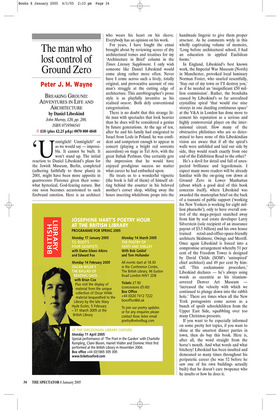The man who lost control of Ground Zero
Peter J. M. Wayne
BREAKING GROUND: ADVENTURES IN LIFE AND ARCHITECTURE by Daniel Libeskind John Murray, £20, pp. 288, ISBN 0719566541 ✆ £18 (plus £2.25 p&p) 0870 800 4848 ‘Unm6glich! Unm6glich!’ or as we would say — impossible. It cannot be built. It won’t stand up. The initial reaction to Daniel Libeskind’s plans for the Jewish Museum, Berlin, completed (adhering faithfully to those plans) in 2001, might have been more apposite in quattrocento Florence given their somewhat hysterical, God-fearing nature. But one soon becomes accustomed to such firebrand emotion. Here is an architect who wears his heart on his sleeve. Everybody has an opinion on his work.
For years, I have fought the ennui brought about by reviewing scores of dry architectural tomes and treatises for my ‘Architecture in Brief’ column in the Times Literary Supplement. I only wish someone like Daniel Libeskind would come along rather more often. Never have I come across such a lively, totally original, and provocative account of one man’s struggle at the cutting edge of architecture. This autobiographer’s prose style is as playfully inventive as his realised oeuvre. Both defy conventional categorisation.
There is no doubt that this strange little man with spectacles that look heavier than he does will be considered a genius by future generations. At the age of ten, after he and his family had emigrated to Israel from Lodz in Poland, he was confident and competent enough to appear in concert (playing a bright red sorrento accordion) on stage in Tel Aviv, with the great Itzhak Perlman. One certainly gets the impression that he would have enjoyed prodigious success no matter what career he had embarked upon.
He treats us to a wonderful vignette (the book is full of them) of himself sitting behind the counter in his beloved mother’s corset shop, whiling away the hours inserting whalebone props into the handmade lingerie to give them proper structure. As he comments wryly in this wholly captivating volume of memoirs, ‘Long before architectural school, I had an education in applied Euclidean forms.’ In England, Libeskind’s best known work, the Imperial War Museum (North) in Manchester, provoked local luminary Norman Foster, who snarled resentfully, ‘Stay out of my town or I’ll destroy you,’ as if he needed an ‘insignificant £50 million commission’. Rather, the brouhaha caused by Libeskind’s so far unrealised crystalline spiral ‘that would rise nine storeys in one dazzling continuous space’ at the V&A in London has done more to cement his reputation as a serious and highly controversial player on the international circuit. How many of the obstructive philistines who are so determined to have none of this Libeskindian vision are aware that if all the spiral’s walls were unfolded and laid out side by side, they would reach exactly from one end of the Exhibition Road to the other?
He’s a devil for detail and full of unexpected brilliance and legerdemain. I expect many more readers will be already familiar with the on-going row down at Ground Zero in Lower Manhattan (about which a good deal of this book concerns itself), where Libeskind was awarded the masterplan brief on the back of a tsunami of public support (‘working for New Yorkers is working for eight million pharaohs’), only to have overall control of the mega-project snatched away from him by real estate developer Larry Silverstein (sole recipient of an insurance payout of $3.5 billion) and his own house trained retail-and-office-space-friendly architects Skidmore, Owings and Merrill. Once again Libeskind is forced into a compromise arrangement whereby 51 per cent of the Freedom Tower is designed by David Childs (SOM’s ‘uninspired’ chief architect) and 49 per cent by himself. ‘This cockamamie procedure,’ Libeskind declares — he’s always using words as eccentric as his titaniumcovered Denver Art Museum — ‘increased the velocity with which we continued to plunge down into the rabbit hole.’ There are times when all the New York protagonists come across as a bunch of spoilt schoolchildren from the Upper East Side, squabbling over too many Christmas presents.
If you want to be especially informed on some pretty hot topics, if you want to shine at the smartest dinner parties in town, then do buy this book. Here is, after all, the word straight from the horse’s mouth. And what words and what bitchery! Libeskind has been insulted and demeaned so many times throughout his peripatetic career (he was 52 before he saw one of his own buildings actually built) that he doesn’t care twopence who he insults or how he does it. Perhaps this is the way of genius. Say what you will about the size of Libeskind’s ego (it is gargantuan), there is no question about his place in the first rank of architects working today. Romantic, expressionistic, iconoclastic, he is all of this and more — an adroit manipulator of light, a crack-and-fissure aesthete, a devoted husband, father and son who can rise to any occasion. Without doubt he is at his most brilliant when called upon to enclose space around the emotions of major tragedy.
The most moving scene in this visceral, very personal odyssey comes at a reception in New York. A man approaches him with a chart that, when unrolled, looks like a pointillist canvas of multitudinous red dots. Then the stranger reveals that these dots represent the bodies and parts of bodies recovered after the wreckage of Minoru Yamasaki’s once proud Twin Towers had been removed. Together, the two men begin to cry, right there at the party, in the midst of the assembled glitterati. Later on, by now heartily sick of the back-stabbing nature of many prime movers, Libeskind opines that he ‘can’t help feeling a little bit like the Emperor Nero, watching as Rome is burning ...’ Breaking Ground is full of surreal images and obscure asides like that. It’s all rather disturbing at times, but always enthralling.











































 Previous page
Previous page